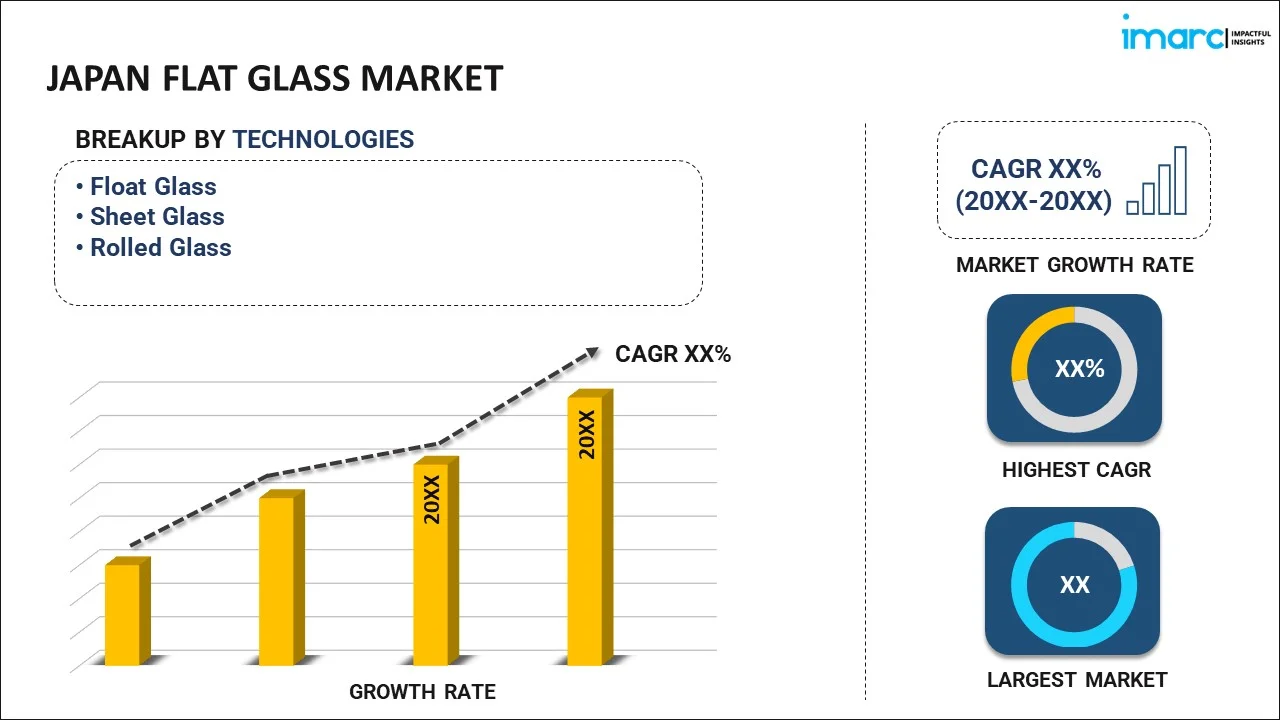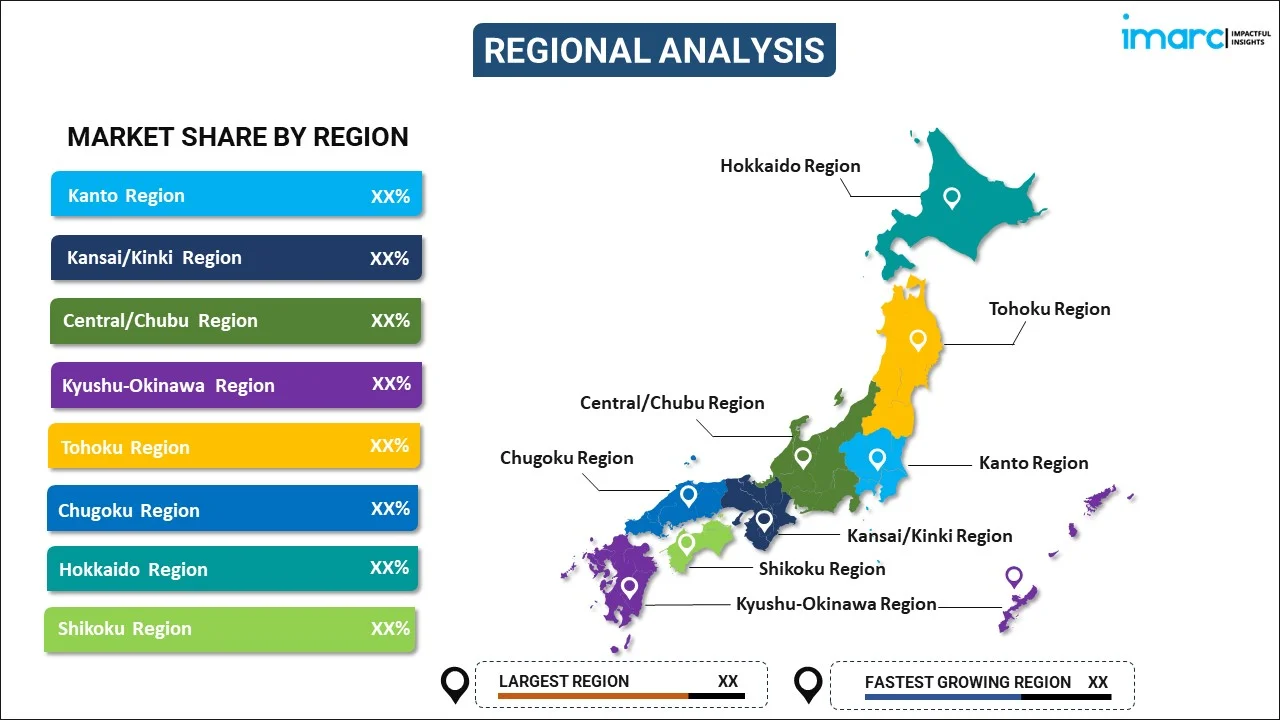
Japan Flat Glass Market Report by Technology (Float Glass, Sheet Glass, Rolled Glass), Product Type (Basic Float Glass, Toughened Glass, Coated Glass, Laminated Glass, Insulated, Extra Clear Glass, and Others), End Use Industry (Construction, Automotive, Solar Energy, Electronics, and Others), and Region 2025-2033
Market Overview:
Japan flat glass market size reached USD 7,067.4 Million in 2024. Looking forward, IMARC Group expects the market to reach USD 11,432.9 Million by 2033, exhibiting a growth rate (CAGR) of 5.5% during 2025-2033. The increasing usage of smart glass in various applications, such as windows, partitions, and automotive sunroofs, that can change its transparency or opacity based on environmental conditions or user preferences, is primarily driving the market.
|
Report Attribute
|
Key Statistics
|
|---|---|
|
Base Year
|
2024
|
|
Forecast Years
|
2025-2033
|
|
Historical Years
|
2019-2024
|
|
Market Size in 2024
|
USD 7,067.4 Million |
|
Market Forecast in 2033
|
USD 11,432.9 Million |
| Market Growth Rate 2025-2033 | 5.5% |
Flat glass is a versatile and commonly used material in various industries, known for its smooth and flat surface. It is primarily composed of silica (sand), soda ash, and limestone, which are melted together to form a molten glass that is then rolled into flat sheets. These sheets can be further processed to meet specific requirements. In construction, flat glass is a fundamental component for windows, doors, and facades, providing transparency while insulating against weather conditions and noise. It also plays a crucial role in automotive manufacturing, forming windshields and windows for vehicles. Additionally, it is utilized in the production of mirrors, glass furniture, and display screens. Flat glass can be modified for enhanced properties, such as tempered glass for increased strength and safety or coated glass for improved energy efficiency and UV protection. Its versatility and adaptability make it an indispensable material in modern architecture, transportation, and consumer electronics.
Japan Flat Glass Market Trends:
The flat glass market in Japan is experiencing robust growth, driven by a confluence of factors that have reshaped the industry landscape. To begin with, the burgeoning construction sector has been a pivotal driving force. Rapid urbanization and infrastructural development projects have heightened the demand for flat glass in commercial and residential buildings. Moreover, the increasing emphasis on energy efficiency and sustainability has steered the market, as flat glass is a critical component in energy-efficient building designs. Consequently, stringent regulations promoting green construction have propelled the adoption of advanced flat glass technologies. Furthermore, the automotive industry's evolution towards lightweight and eco-friendly vehicles has been instrumental. Flat glass has extensive applications in automotive glazing, where it contributes to enhanced safety, aesthetics, and fuel efficiency. This burgeoning automotive sector has created a substantial demand for specialized flat glass products. Additionally, the expanding consumer electronics industry, along with the proliferation of smartphones, tablets, and smart TVs that require high-quality, durable flat glass screens, is expected to drive the flat glass market in Japan during the forecast period.
Japan Flat Glass Market Segmentation:
IMARC Group provides an analysis of the key trends in each segment of the market, along with forecasts at the country level for 2025-2033. Our report has categorized the market based on technology, product type, and end use industry.
Technology Insights:

- Float Glass
- Sheet Glass
- Rolled Glass
The report has provided a detailed breakup and analysis of the market based on the technology. This includes float glass, sheet glass, and rolled glass.
Product Type Insights:
- Basic Float Glass
- Toughened Glass
- Coated Glass
- Laminated Glass
- Insulated
- Extra Clear Glass
- Others
A detailed breakup and analysis of the market based on the product type have also been provided in the report. This includes basic float glass, toughened glass, coated glass, laminated glass, insulated, extra clear glass, and others.
End Use Industry Insights:
- Construction
- Automotive
- Solar Energy
- Electronics
- Others
The report has provided a detailed breakup and analysis of the market based on the end use industry. This includes construction, automotive, solar energy, electronics, and others.
Regional Insights:

- Kanto Region
- Kansai/Kinki Region
- Central/ Chubu Region
- Kyushu-Okinawa Region
- Tohoku Region
- Chugoku Region
- Hokkaido Region
- Shikoku Region
The report has also provided a comprehensive analysis of all the major regional markets, which include Kanto Region, Kansai/Kinki Region, Central/ Chubu Region, Kyushu-Okinawa Region, Tohoku Region, Chugoku Region, Hokkaido Region, and Shikoku Region.
Competitive Landscape:
The market research report has also provided a comprehensive analysis of the competitive landscape in the market. Competitive analysis such as market structure, key player positioning, top winning strategies, competitive dashboard, and company evaluation quadrant has been covered in the report. Also, detailed profiles of all major companies have been provided.
Japan Flat Glass Market Report Coverage:
| Report Features | Details |
|---|---|
| Base Year of the Analysis | 2024 |
| Historical Period | 2019-2024 |
| Forecast Period | 2025-2033 |
| Units | Million USD |
| Scope of the Report | Exploration of Historical and Forecast Trends, Industry Catalysts and Challenges, Segment-Wise Historical and Predictive Market Assessment:
|
| Technologies Covered | Float Glass, Sheet Glass, Rolled Glass |
| Product Types Covered | Basic Float Glass, Toughened Glass, Coated Glass, Laminated Glass, Insulated, Extra Clear Glass, Others |
| End Use Industries Covered | Construction, Automotive, Solar Energy, Electronics, Others |
| Regions Covered | Kanto Region, Kansai/Kinki Region, Central/ Chubu Region, Kyushu-Okinawa Region, Tohoku Region, Chugoku Region, Hokkaido Region, Shikoku Region |
| Customization Scope | 10% Free Customization |
| Post-Sale Analyst Support | 10-12 Weeks |
| Delivery Format | PDF and Excel through Email (We can also provide the editable version of the report in PPT/Word format on special request) |
Key Questions Answered in This Report:
- How has the Japan flat glass market performed so far and how will it perform in the coming years?
- What has been the impact of COVID-19 on the Japan flat glass market?
- What is the breakup of the Japan flat glass market on the basis of technology?
- What is the breakup of the Japan flat glass market on the basis of product type?
- What is the breakup of the Japan flat glass market on the basis of end use industry?
- What are the various stages in the value chain of the Japan flat glass market?
- What are the key driving factors and challenges in the Japan flat glass?
- What is the structure of the Japan flat glass market and who are the key players?
- What is the degree of competition in the Japan flat glass market?
Key Benefits for Stakeholders:
- IMARC’s industry report offers a comprehensive quantitative analysis of various market segments, historical and current market trends, market forecasts, and dynamics of the Japan flat glass market from 2019-2033.
- The research report provides the latest information on the market drivers, challenges, and opportunities in the Japan flat glass market.
- Porter's five forces analysis assist stakeholders in assessing the impact of new entrants, competitive rivalry, supplier power, buyer power, and the threat of substitution. It helps stakeholders to analyze the level of competition within the Japan flat glass industry and its attractiveness.
- Competitive landscape allows stakeholders to understand their competitive environment and provides an insight into the current positions of key players in the market.
Need more help?
- Speak to our experienced analysts for insights on the current market scenarios.
- Include additional segments and countries to customize the report as per your requirement.
- Gain an unparalleled competitive advantage in your domain by understanding how to utilize the report and positively impacting your operations and revenue.
- For further assistance, please connect with our analysts.
 Inquire Before Buying
Inquire Before Buying
 Speak to an Analyst
Speak to an Analyst
 Request Brochure
Request Brochure
 Request Customization
Request Customization




.webp)




.webp)












